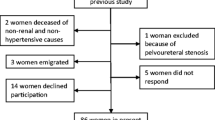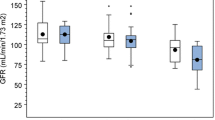Abstract
Objective
To examine the effect of hyperbilirubinemia on lower urinary tract function.
Methods
The study was conducted on 29 patients with suspected Gilbert’s syndrome (GS), and who were subjected to fasting test for diagnostic purpose. The uroflowmetric test was performed after 24 h of fasting and after 24 h of hypercaloric intake.
Results
After a 24 h fasting period, when bilirubin in the serum was at its highest concentration, 31% of patients had abnormal uroflowmetric patterns. Patients with abnormal uroflowmetric patterns had higher conjugated bilirubin after 24 h fasting period than patients with normal pattern (p = 0.012). After a 24 h of hypercaloric intake, all 29 patients had a normal (bell-shaped) uroflowmetric pattern.
Conclusions
The results imply that hyperbilirubinemia might be a predisposing factor for intermittent lower urinary tract dysfunction in children.
Similar content being viewed by others
References
Pflueger A, Croatt AJ, Peterson TE, et al. The hyperbilirubinenic Gunn rat is resistant to the pressure effects of angiotensin II. Am J Physiol Renal Physiol. 2005;288:F552–8.
Vitek L, Novotny L, Sprel M, Holaj R, Spacil J. The inverse association of elevated serum bilirubin levels with subclinical carotid atherosclerosis. Cerebrovasc Dis. 2006;21:408–14.
Erdogan D, Gullu H, Yildirim E, et al. Low serum bilirubin levels are independently and inversely related to impaired flow-mediated vasodilation and increased carotid intima-media thickness in both men and women. Atherosclerosis. 2006;184:431–7.
Kawamura K, Ishikawa K, Wada Y, et al. Bilirubin from heme oxygenase-1 attenuates vascular endothelial activation and dysfunction. Arterioscler Thromb Vasc Biol. 2005;25:155–60.
Murat N, Kasap B, Kavukcu S, Soylu A, Turkmen M, Gidener S. In vitro analysis of the effect of hyperbilirubinemia on rabbit ureter and bladder. Pediatr Nephrol. 2006;21:328–32.
Mattsson SH. Voiding frequency volumes and intervals in healthy school children. Scand J Urol Nephrol. 1994;28:1–11.
Neveus T, von Gontard A, Hoebeke P, et al. The standardization of terminology of lower urinary tract function in children and adolescents: report from the Standardisation Committee of the International Childrens Continence Society. J Urol. 2006;176:314–24.
Lee SD, Sohn DW, Lee JZ, Park NC, Chung MK. An epidemiological study of enuresis in Korean children. BJU Int. 2000;85:869–73.
Dogan HS, Akpinar B, Gurocak S, Akata D, Bakkaloglu M, Tekgul S. Non-invasive evaluation of voiding fluction in asymptomatic primary school children. Pediatr Nephrol. 2008;23:1115–22.
Gutierrez SC. Urine flow in childhood: a study of flow chart parameters based on 1, 361 uroflowmetry tests. J Urol. 1997;157:1426–8.
Adachi Y, Yamashita M, Nanno T, Yamamoto T. Proportion of conjugated bilirubin in bile in relation to bilirubin UDP-glucuronyltranferase activity. Clin Biochem. 1990;23:131–4.
Berk PD, Bloomer JR, Hower RB, Berlini N. Consitutional hepatic dysfunction (Gilbert’s syndrome): a new definition based on kinetic studies with unconjugated radiobilirubin. Am J Med. 1970;49:296–305.
Powel LW, Hemingway E, Billing BH, Sherlock S. Idiopathic unconjugated hyperbilirubinaemia (Gilbert’s syndrome). A study of 42 families. N Engl J Med. 1995;277:1108–12.
Bosma P, Chowdhary JR, Jansen PH. Genetic inheritence of Gilbert’s syndrome. Lancet. 1995;346:314–5.
Hirschfield GM, Alexander GJ. Gilbert’s syndrome: an overview for clinical biochemists. Ann Clin Biochem. 2006;43:340–3.
Olsson R, Bliding Å, Jagenburg L, et al. Gilbert’s syndrome – does it exist? Acta Med Scand. 1988;244:485–90.
Valesini G, Conti F, Priori R, Balsano F. Gilbert’s syndrome and chronic fatigue syndrome. Lancet. 1993;341:1162–3.
Norgaard JP, van Gool JD, Hjalmas K, Djurhuus JC, Hellstrom AL. Standardization and definitions in lower urinary tract dysfunction in children. International children’s continence society. Br J Urol. 1998;81:1–16.
Sarici SU, Kul M, Alpay F. Neonatal jaundice coinciding with or resulting from urinary tract infection? Pediatrics. 2003;112:1212–3.
Ghaemi S, Fesharaki RJ, Kelishadi R. Late onset jaundice and urinary tract infection in neonates. Indian J Pediatr. 2007;74:139–41.
Gutierrez SC. The study of urinary flow in 3 to 14 year-old children. Urinary flow rate nomograms. Cir Pediatr. 1996;9:91–7.
Bower WF, Kwok B, Yeung CK. Variability in normative urine flow rates. J Urol. 2004;171:2657–9.
Conflict of Interest
None.
Role of Funding Source
None.
Author information
Authors and Affiliations
Corresponding author
Rights and permissions
About this article
Cite this article
Stojanović, V., Vukavić, T. Hyperbilirubinemia and Intermittent Lower Urinary Tract Dysfunction. Indian J Pediatr 78, 688–692 (2011). https://doi.org/10.1007/s12098-010-0346-0
Received:
Accepted:
Published:
Issue Date:
DOI: https://doi.org/10.1007/s12098-010-0346-0




